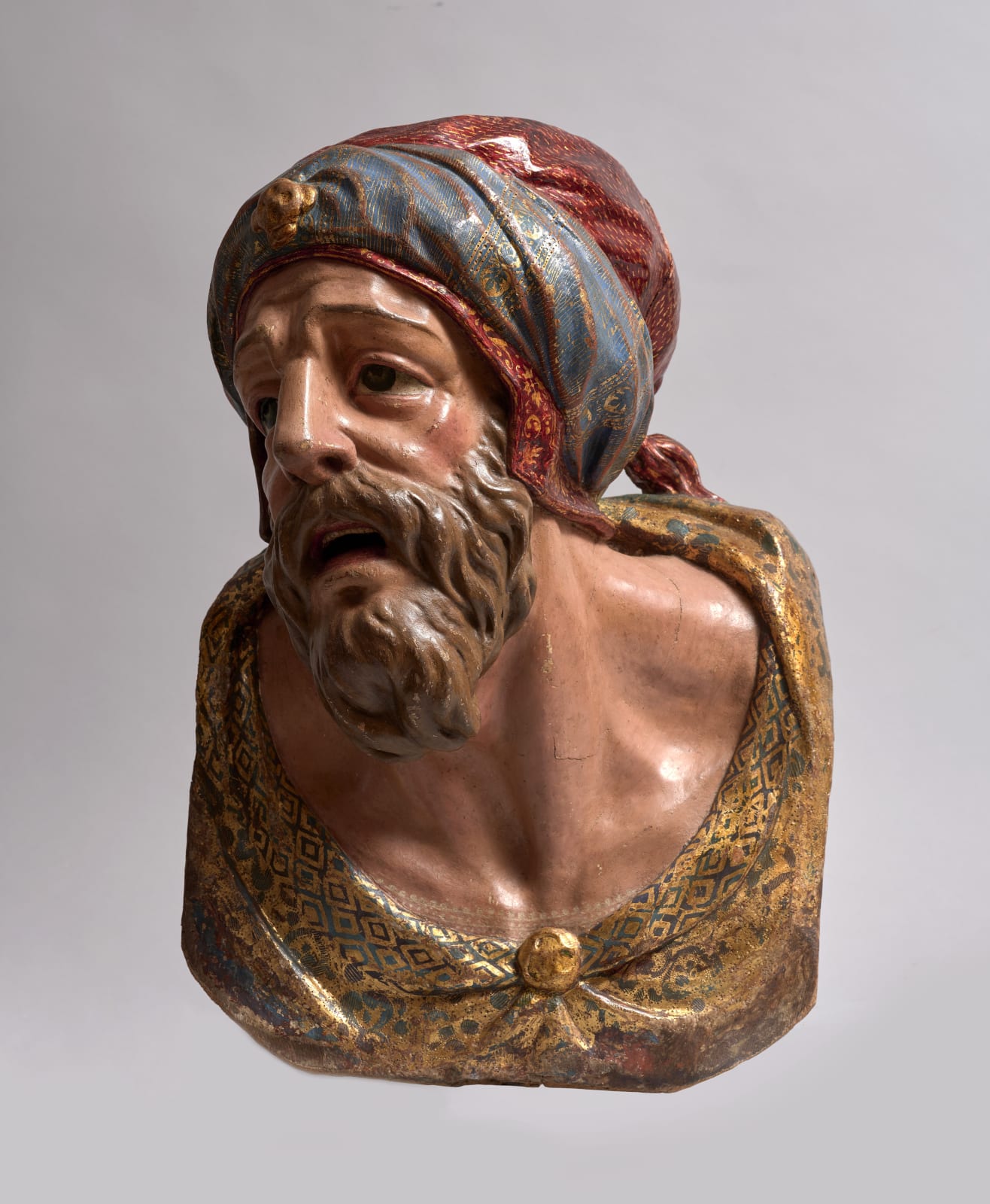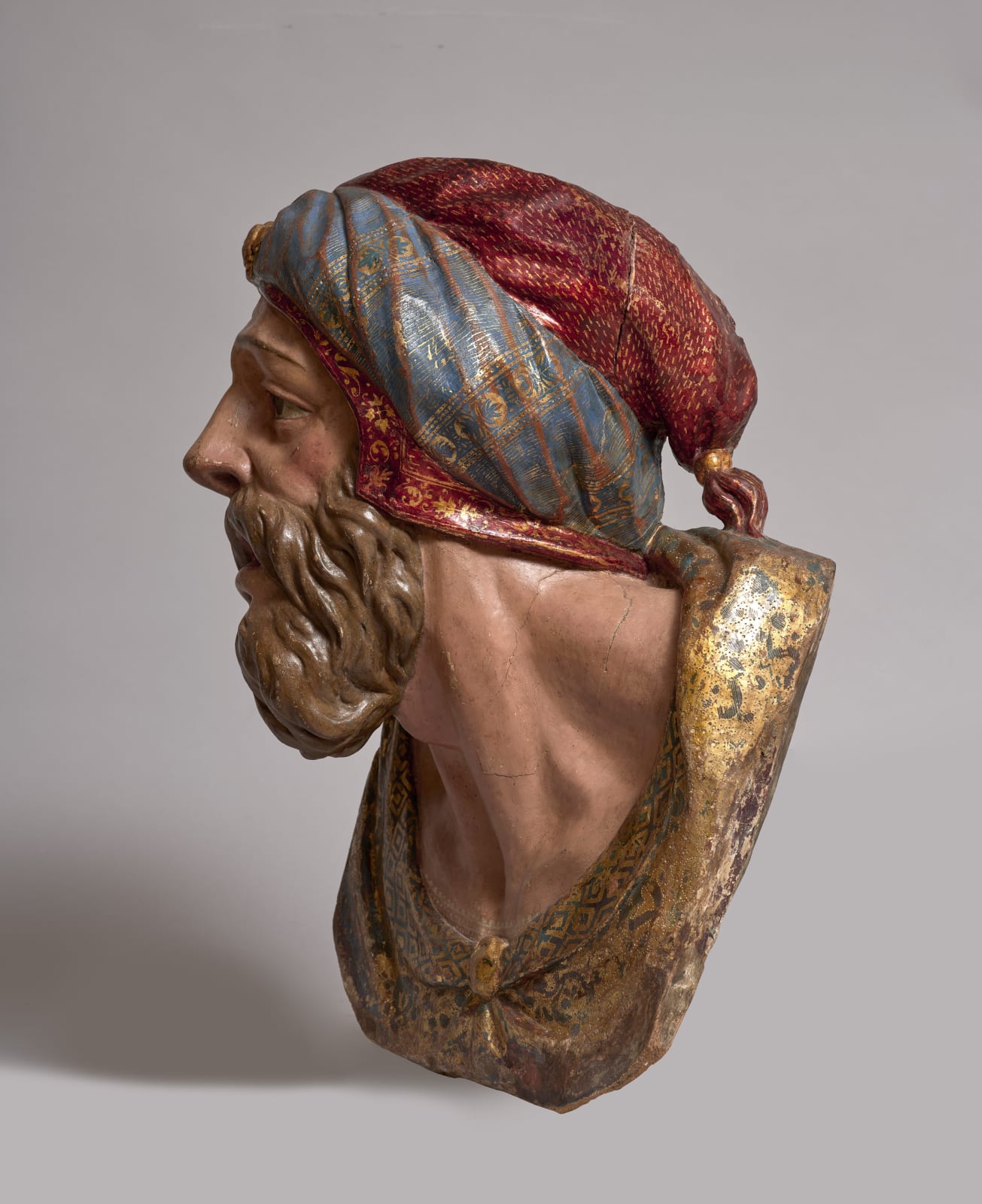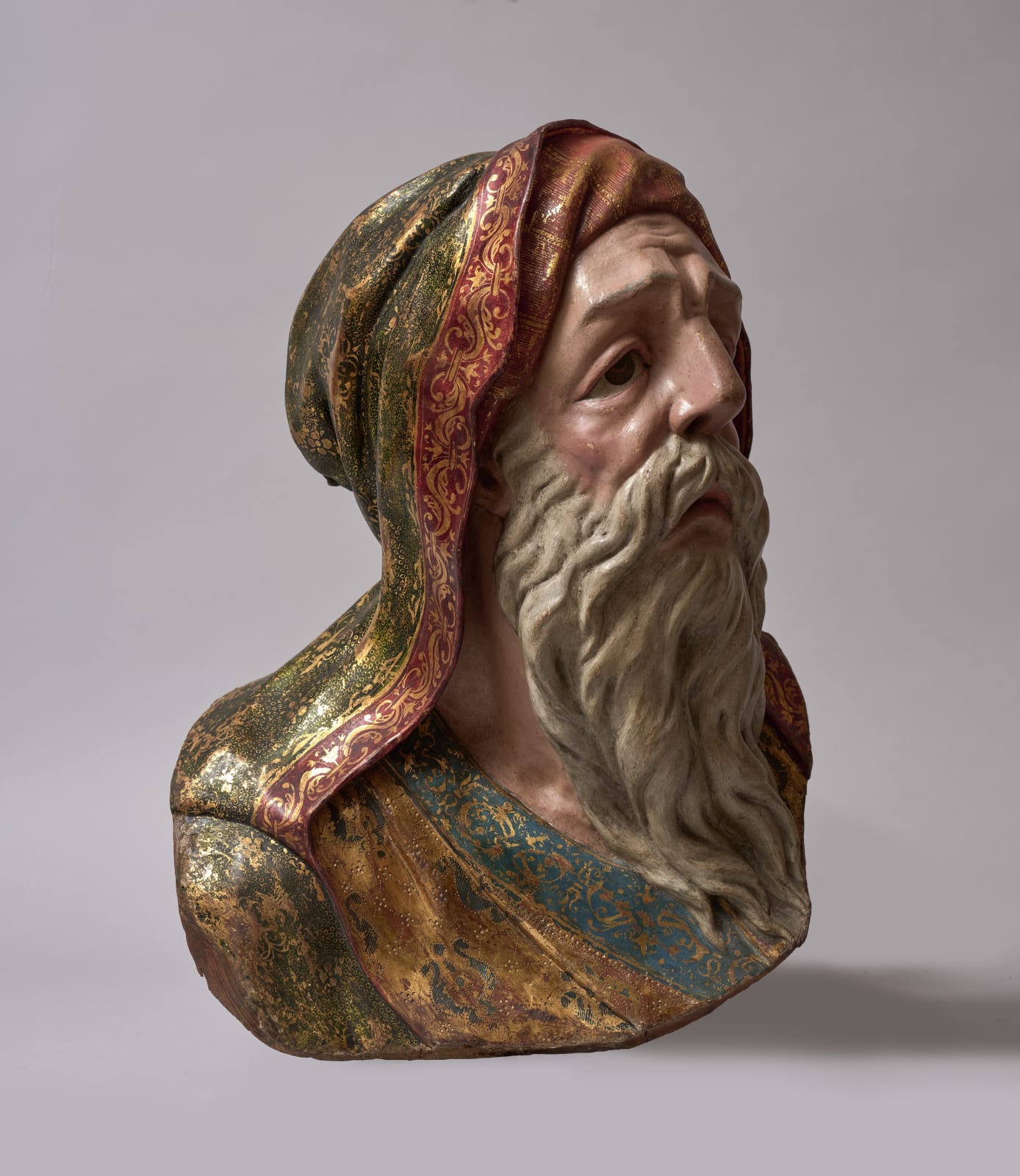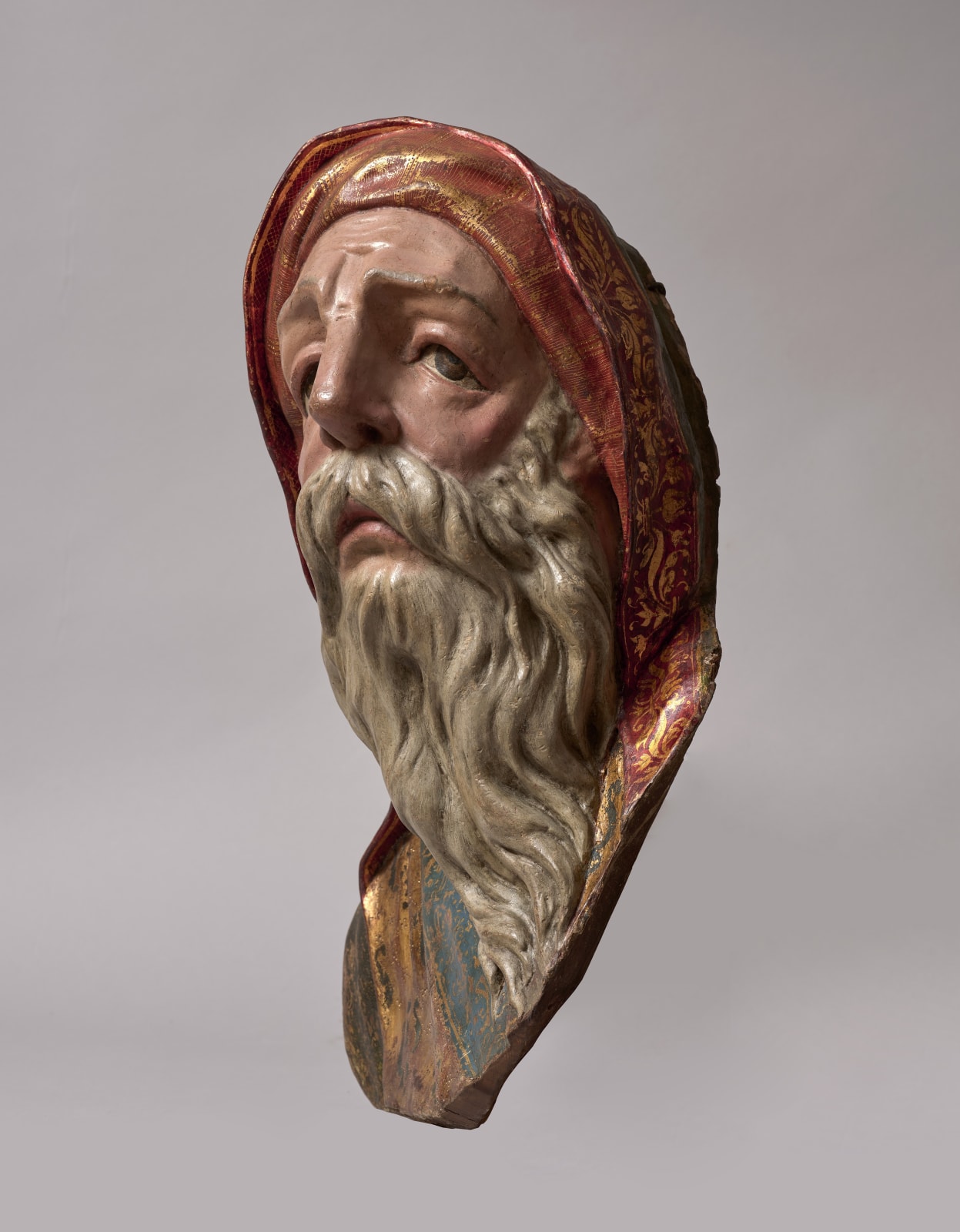ALONSO BERRUGUETE
Further images
-
(View a larger image of thumbnail 1
)

-
(View a larger image of thumbnail 2
)

-
(View a larger image of thumbnail 3
)

-
(View a larger image of thumbnail 4
)

-
(View a larger image of thumbnail 5
)

-
(View a larger image of thumbnail 6
)

-
(View a larger image of thumbnail 7
)

-
(View a larger image of thumbnail 8
)

-
(View a larger image of thumbnail 9
)

-
(View a larger image of thumbnail 10
)

-
(View a larger image of thumbnail 11
)

-
(View a larger image of thumbnail 12
)

-
(View a larger image of thumbnail 13
)

-
(View a larger image of thumbnail 14
)

-
(View a larger image of thumbnail 15
)

-
(View a larger image of thumbnail 16
)

-
(View a larger image of thumbnail 17
)

Provenance
Private Collection
We see here two male portrait sculptures represented to shoulder-length and carved in polychromewood. They areJoseph of ArimatheaandNicodemus,characters found in Christian hagiography,specifically in iconography on theBurial of Jesus,alongside theVirgin Mary, Saint John, Mary Magdaleneand one other of the sainted women, known asMary of Clopas.
From a technical point of view, thebusts were carved from a pine wood trunk, one block for each bust,partially leveled on the back, and so are very heavy. The back is left uncarved in both pieces, provingthey were created to hang from a vertical surface. Abundant grains and knots are visible on the back.
The polychromecarried out using thesgraffitotechnique: different plain colors are applied over acontinuous layer of polished gold leaf with an egg binder, making the gilt reappear using a boxwoodbrush. Flesh tones are painted in tempera and polished, making the reddish cheeks and the moustacheand beard stand out, grey in the case ofJoseph of Arimatheaand brown in the case ofNicodemus.In bothcases, the iris in their eyes is painted in dark grey and with a two different tones of blue, respectively,while their eyebrows are painted grey in the former and brown in the latter. The importance of theclothes that cover them stands out, imitating rich fabrics with different motifs.
Joseph of Arimatheawears a red cape with adorned hoodand gilded trimming with arabesques and,below it, a bluish grey turban appears with some gilt and dotted remains.
Nicodemuscovers himself with a light grey turban with blue stripes, dots and gilded trimming,presenting a mounted stone at the center andfolded over a brown coif that simulates leather. Over theturban, he wears a red bonnet with gilded arabesques on the side of which hangs a gilded tassel. Thetunic is light in color with a wide border at the neck, decorated in similar fashion and held with a buttonat the center.
Considering both the model and style, and the techniques used in their creation, as well as thepolychrome, these carvings fall within the artistic production of Alonso Berruguete.
Alonso Berruguete (Paredes de Nava, h. 1488-Valladolid, 1561) introduced Mannerism in Spain. Aftera long stay in Italy, on his return to his home country, he was forced to adapt the secular principles ofItalian sculpture to the Spanish artistic spirit, where religion permeated everything. His creativity wassuch that he became an artist of great personality, creating a style based on proportion, the importanceof drawing and, especially, the distortion of figures. He used the stretched ten-face standard and cameup with stylized and nervous-looking models that demonstrate his fast manner of working, moreconcerned with expression than with the perfection of shape.
The models created by Alonso Berruguete are very realistic and very expressive. Their physiognomicfeatures are repeated across many of them. They have elongated faces, slanting and sunken eyes placedat an angle, a furrowed brow with arched eyebrows, marked cheeks, the nose high and thin, and a smallmouth. We find all of these characteristics in the busts ofJoseph of ArimatheaandNicodemus,althoughthe mouth in the former is closed, his expression a grimace of deep sadness, and is open in the latter,showing his top teeth, with a yearning expression. In regard to their moustache and beard, they are carved in thick, wavy locks that are identical to those found in other representations of Prophets,Patriarchs or Saints created by Berruguete. The way the models are presented, the bust to the front andtheir head turned slightly to one side, frontality broken by the turned face, is one of the artist’s mostoriginal characteristics and is palpable in the two pieces presented here.
Furthermore, the incorporation of busts in the structure of his altarpieces was a decorative resourcefrequently used by Alonso Berruguete. Inspired by Italian art, in turn taken from the ancient world,more specifically from Roman mosaics, sarcophagi, medallions or in the several reliefs of emperors andcharacters in ancient times, they were commonplace among Renaissance artists. Berruguete included itin the altarpiece of San Benito el Real in Valladolid, undertaken between 1526 and 1532, which is housed,disassembled, at the Museo Nacional de Escultura (National Sculpture Museum). This gigantic workwas composed of paintings, reliefs and imagery with scenes from the life of Christ and Saint Benedictine,to whom the altarpiece is dedicated. The image of Christ that formed part of the Calvary is three meterstall, while the Virgin and Saint John are almost two meters tall. Many other saints, prophets andpatriarchs appear in the altarpiece but what we wish to point out here are theBusts of the Prophetsthatemerged from roundels in the end panels, contemplating the scenes from above with great realism.
















